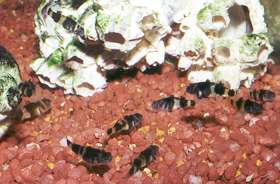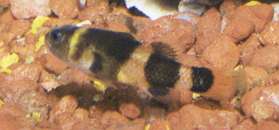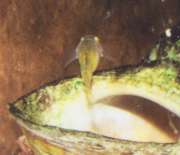 |
| Bumblebee Gobies belong to the genus Brachygobius. Since brachy is Greek, for short, that comes to 'short goby' -- so far an accurate description for these approximately 1 1/2 inch (40 mm) fish. The goby part has something to do with their having 2 dorsal fins, (or one interrupted one) and more to do with their ventral fins being fused to form a kind of natural suction cup which allows them to stick themselves to almost any surface at almost any angle.
After much eye strain both by me and my friend Paul McFarlane, trying to accurately count the rays in their anal fins, our best guess as to species is 'nunus', (supposed to have 1 spine and 7 rays). I understand that a nunus is a friendly little hole-dwelling creature in mythology and, once again, this fits our fish very well.
The 'Bumblebee' part of their common name obviously has to do with their big heads, (compared to their bodies), the 4 brown/black vertical stripes on a yellow/gold background and their habit of usually 'buzzing' from one surface |
to another as a means of moving about their tank. The several species of Bumblebee Gobies come from Asia, where they are found in salt water swamps and stream estuaries in India, Thailand, Indonesia, Borneo and Malaysia. Although most of them can tolerate completely fresh water, they are more comfortable in a brackish environment and we are in the habit of adding at least 2 teaspoons of artificial sea salt mix per gallon to their tank. They may eat a bit of dried flake food but it doesn't get them excited. Live and frozen foods are their favourites. Whiteworms are quickly gobbled up. Daphnia and brine shrimp don't last very long either. When those aren't available, frozen blood worms and shrimp seem fairly acceptable. We bought our first dozen of these neat little creatures some years ago. The literature suggested that they were probably the easiest of the gobies to breed and we found them attractive. At first we put them in a large tank, (100 gallons), where they hopped about happily but did nothing breeding-wise. Some accounts of successful spawnings suggested a small tank, so we moved them to a 5 gallon setup with some snail shells and bricks for caves. Over the next couple of years nothing happened except that from time to time one died. We began to wonder if, by some fluke, we didn't have both sexes. We pretty much gave up on them and there was just one left in the tank. It was four or |
five years old and healthy. About that time we found a tank full of tiny bumblebees in a pet store at a reasonable price and decided to start again. A dozen were purchased and placed in a ten gallon tank with an undergravel filter and a cluster of barnacle shells for caves. This group was fed on live and frozen stuff and, finally, after they had grown some, the one 'left over' was moved in with them. Some of them grew chubbier than the rest but still no spawning.  Group cleaning up whiteworms We decided to make a concentrated effort. Larger and more frequent water changes were made, (twice a week), and more salt was added bringing it up to about a tablespoon per gallon. As much as possible they were spoiled with live food.
Late in September 2000 I noticed one morning that something strange was happening. For a few minutes I thought some other species of fish had jumped into that tank. Two or three of them were swimming about rapidly like regular fish, (not |


